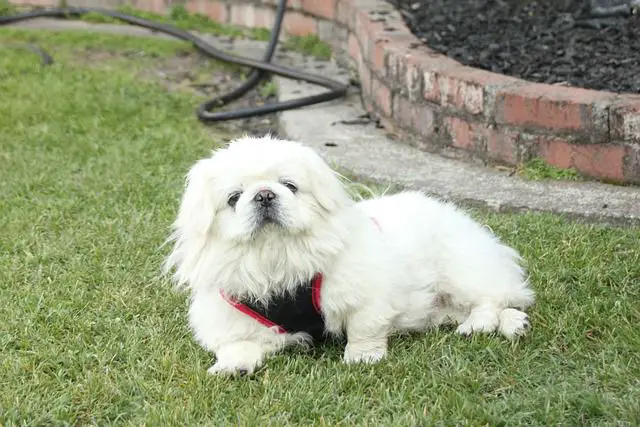Simplified Pekingese Breed Information & Facts

Let’s discuss Pekingese breed information and some facts you should know…
Are you looking for a furry companion that will steal your heart with its adorable squishy face and charming personality? If so, let me introduce you to the Pekingese!
These little dogs may be small in size, but they definitely pack a punch when it comes to personality.
In this blog post, we’ll be sharing some fascinating Pekingese facts and breed information that will make you fall in love with this lovable breed even more.
So without further ado, let’s dive into the wonderful world of Pekingese dogs!
Origins of the Pekingese dog breed
The Pekingese breed originated in China during the Tang Dynasty in the 8th century. They were bred by Chinese emperors to resemble guardian lions and were highly valued as a symbol of nobility and prestige.
The breed almost died out with the fall of the Qing Dynasty in 1911, but was saved through the efforts of breed enthusiasts. Today, Pekingese are popular companion dogs known for their affectionate and loyal nature, as well as their distinctive appearance.
Pekingese Appearance

The Pekingese breed is known for its distinctive appearance and luxurious coat. They may also have a black mask on their face, further enhancing their unique appearance.
Additionally, Pekingese have long, flowing coat that requires daily maintenance for show dogs but can be kept trimmed short for companion animals.
Modern breeders and dog show judges seem to prefer the long-haired type over the more traditional spaniel-type coat.
Pekingese Colors and Patterns
Pekingese dogs come in a variety of colors and patterns. They can be solid or bi-colored, tri-colored, sable, or brindled. In terms of solid colors, white and fawn are common shades for the Pekingese.
Other common colors include black, red, black, and tan. Pekingese can also have different black masks and white markings. Combinations of these colors and patterns are also possible.
Pekingese Size and Weight
The Pekingese size ranges from 6 to 9 inches in height and they can weigh up to 14 pounds. They are part of the toy group and are usually under 14 pounds and about 8 inches tall.
Male and female Pekingese have an average weight of 11 pounds (5 kg). When fully grown, they should be about 6 to 9 inches in height. These sizes and weights may vary slightly depending on the individual dog.
Learn more about Pekingese size and weight.
Pekingese Temperament and Personality
The Pekingese dog is known to have a friendly, social, and affectionate personality with their family. They are intelligent, affectionate, and can develop strong connections with their owners.
However, they can also be aloof and almost wary of strangers. This characteristic makes them excellent watchdogs. The Pekingese is also described as dignified, supremely confident, and one of the most independent (and stubborn) of the toy breeds.
They are calm and quiet indoors but can be quite stubborn if not properly trained. Overall, the Pekingese have a unique and loyal personality, but socialization and proper training are important to ensure they become well-behaved and happy pets.
Learn more about Pekingese temperaments.
Pekingese dogs require early socialization and obedience training to help keep them from barking and to develop good behavior. Like any breed, Pekingese puppies need to be house-trained, and with proper training and socialization, they can be well-behaved and obedient.
Pekingese have a low social/attention need and a moderate tendency to bark. It’s recommended to start obedience training and socialization as early as possible. Regularly bringing a Pekingese pup around people and other dogs can also help with socialization.
Puppy classes can be found through local AKC training clubs and dog training facilities. Proper care and a high-protein diet are also necessary for the well-being of Pekingese puppies and dogs.
Learn more about different ways of socializing Pekingese dogs.
Pekingese Health Considerations

Pekingese have several health considerations to take into account. They are susceptible to eye problems such as dry eye, corneal ulcers, and Progressive Retinal Atrophy (PRA), as well as dental disease.
In addition, Pekingese are a brachycephalic breed, which means they may have difficulty breathing and are prone to Brachycephalic Airway Syndrome.
They also may experience Patellar Luxation, a condition where the kneecap dislocates from its normal position.
Potential Pekingese owners should work with a responsible breeder to learn more about the specific health concerns within the breed.
Pekingese Exercise and Activity Requirements
Pekingese have low exercise requirements, and adult Pekingese typically require about an hour of physical activity per day, which could include two moderate walks of 15 to 20 minutes each.
Additionally, Pekingese require mental stimulation to keep their minds active. They can be prone to obesity, so short daily walks and lively playtime with their owners are recommended.
Overall, Pekingese have a laid-back energy level and do not require excessive amounts of exercise.
Learn more about ways to exercise your Pekingese dog.
Pekingese Feeding and Nutrition
Pekingese feeding and nutrition is an important aspect of their care to ensure they maintain optimal health. A high-quality diet with animal-based protein sources is essential for Pekingese, and their meals should be divided into smaller portions due to their small stomachs.
Commercially prepared dog food is recommended, as it will have all the necessary vitamins and supplements required for a healthy diet. Fresh dog food can be beneficial in contributing to a healthy, active life, and could help prevent some common ailments for the breed.
It’s also important to avoid certain foods that could harm their health. Additionally, proper nutrition and balanced diets are essential for maintaining good ear health in Pekingese. Low-calorie treats can also be given, but it’s important to keep in mind that their diet should consist of mainly dog food.
Learn more about human foods Pekingese can eat and foods they should avoid.
Pekingese Life Expectancy

The average lifespan of a Pekingese is around 12 to 14 years, although some may live up to 18 years.
Short-faced breeds like the Pekingese are prone to certain health issues that may affect their lifespan.
It is essential to provide proper care and attention to your Pekingese in order to ensure they live healthy and happy life.
Pekingese grooming
Pekingese grooming involves maintaining their long, profuse coats through regular bathing and brushing. The coat needs to be brushed at least once a week to prevent matting and tangling, and the dog should be bathed only when they are particularly dirty to avoid drying out the skin.
Pekingese also require regular trimming around their eyes, ears, and paws, and their nails should be trimmed regularly as well.
Shedding is common, so grooming should be done at least twice every month to keep the coat healthy and shiny. Additionally, pushing or pulling the skin tight while clipping can help make the process smoother when trimming.
Pekingese Price
The price of a Pekingese dog can vary depending on various factors such as bloodline and breeder. On average, a Pekingese puppy can cost anywhere from $500 to $3,000.
Some breeders set their Pekingese puppies’ prices closer to the $1,500 to $3,000 range. However, as per the AKC Marketplace, you can expect to pay between $750 and $1,800 for a Pekingese puppy from a reputable breeder, with an average price of around $1,275.
It is important to note that adopting a Pekingese from a rescue can be significantly more affordable, with a cost of around $300 to cover the expenses of caring for the dog before adoption.
Pekingese Popularity
The Pekingese breed is not one of the most popular dog breeds. It is currently ranked as the 49th most common breed registered by the American Kennel Club (AKC) and is considered one of the less popular toy breeds.
As per AKC, there has been a decline in the number of Pekingese registrations over the years.
However, Pekingese dogs were very popular in China and were favored by Chinese emperors and those who lived in their palaces. They were recognized as a breed by the AKC in 1906.
Pekingese Living Environment
Pekingese dogs can adapt to various living conditions, including apartments, but they do need daily exercise and mental stimulation. They can also be prone to allergies and ear infections, so it’s essential to keep their environment clean.
In general, Pekingese dogs make great pets for adults and older children and develop a close bond with their owners. Additionally, it’s a good idea to teach them when to stop barking as some Pekingese tend to bark too much.
Therefore, the best living environment for Pekingese dogs would be a clean and comfortable indoor living space with regular exercise and mental stimulation provided by their owners.
Pekingese dogs with other pets and kids
Pekingese dogs generally get along well with children and cats, but they are not always fond of other dogs. It is important to supervise interactions between Pekes and children, especially those with little exposure to dogs.
They are confident and fearless, but no dog is perfect. It is important to socialize Pekingese dogs with other pets and children from a young age to ensure they develop good relationships with them.
If you are considering getting a Pekingese and have other pets or children, it is best to introduce them slowly and carefully to ensure a positive and safe environment for everyone involved.
Pekingese behavior
Pekingese are known for their affectionate and intelligent nature. However, they can also exhibit some behavioral problems such as stubbornness, aggression, and a tendency to bark excessively.
Pekingese can be aloof with strangers and may be difficult to house-train. They can develop small dog syndrome if not trained properly, which can cause them to become demanding, possessive, and have other behavior issues.
It is important to socialize with Pekingese early to avoid dominance and aggression later in life. If a Pekingese suddenly changes their behavior, it is recommended to consult with a vet in case there is an underlying health issue.
Conclusion
In conclusion, Pekingese dogs are a unique and fascinating breed that has captured the hearts of many dog lovers.
From their lion-like appearance to their affectionate nature, Pekingese dogs are truly one of a kind.
Whether you’re a seasoned dog owner or considering getting a Pekingese for the first time, there’s no doubt that these furry little companions will bring joy and happiness into your life.
So why wait? Start searching for your perfect Pekingese today and experience the joys of this amazing breed for yourself!
